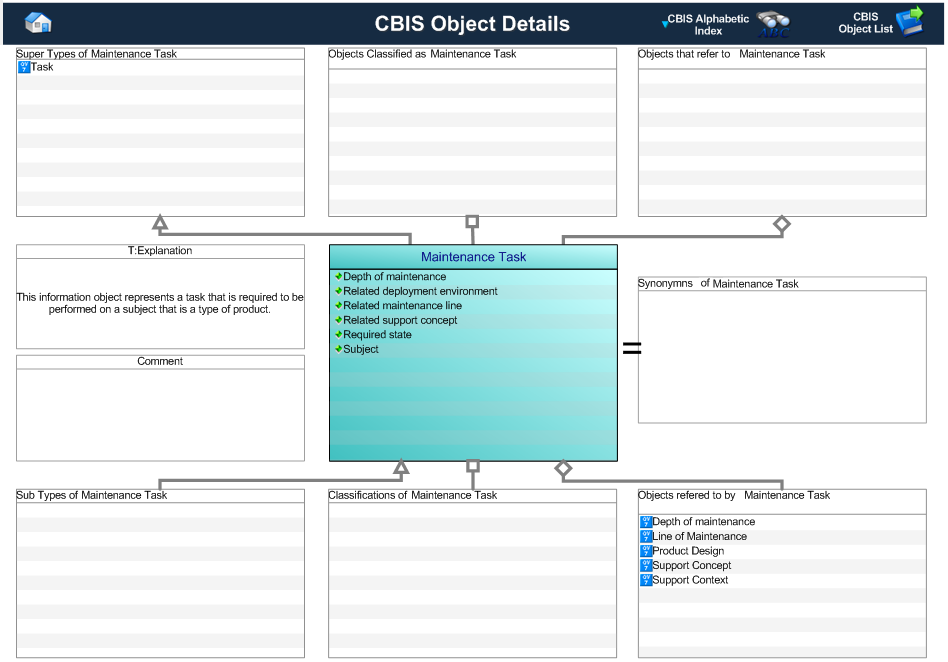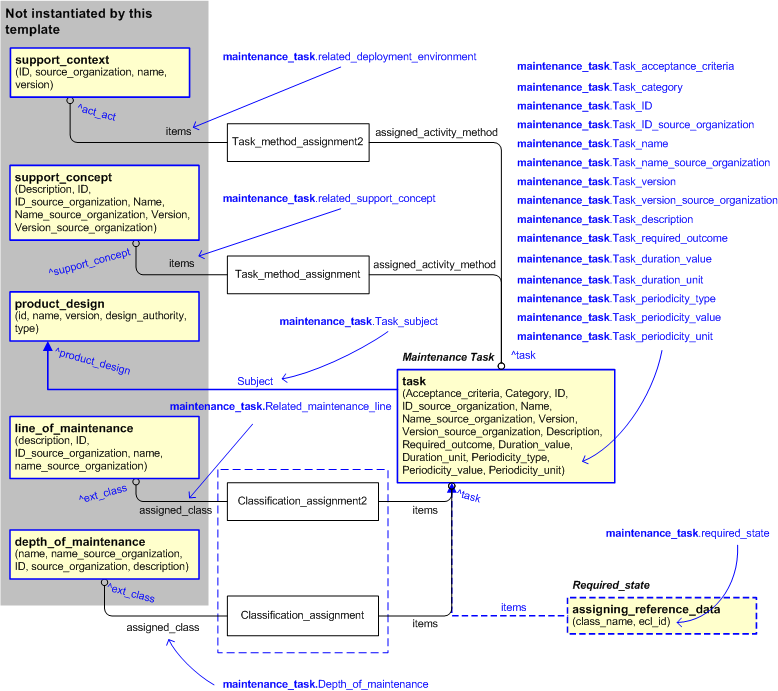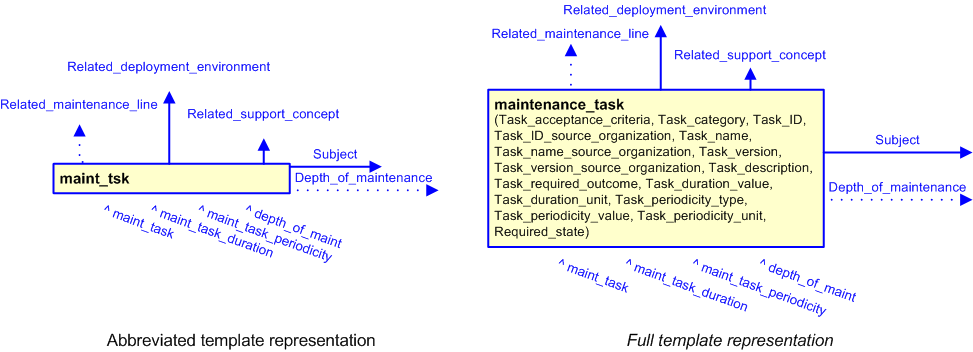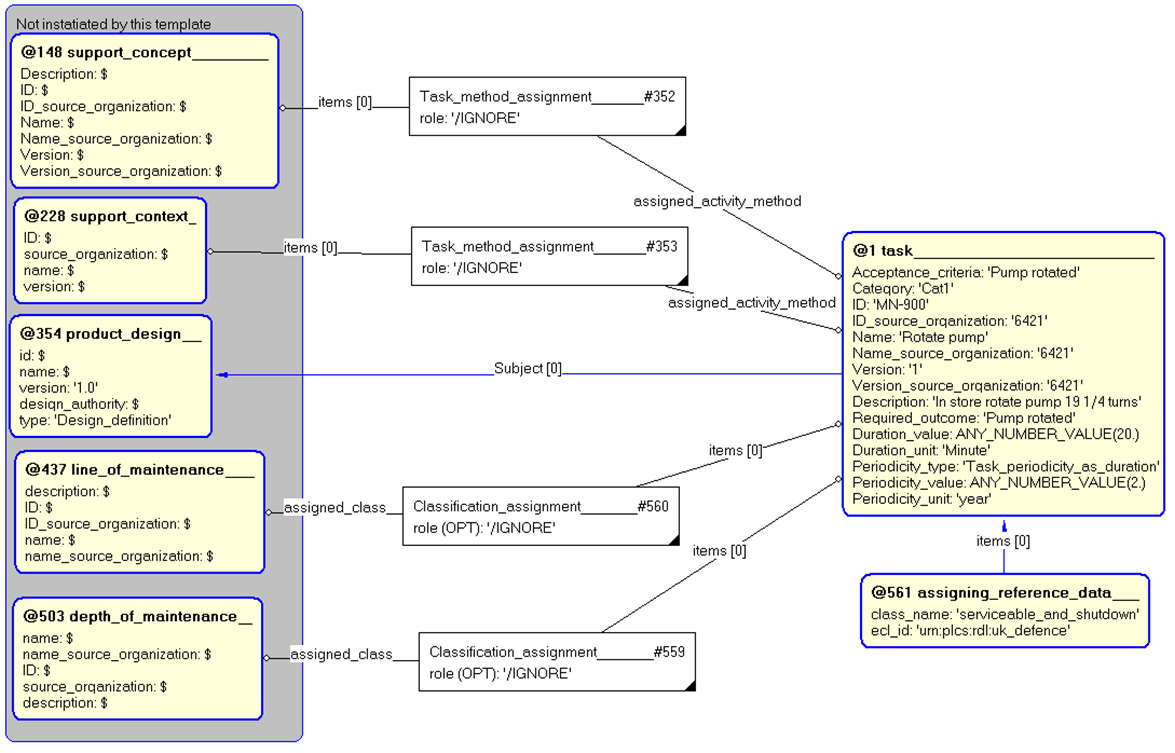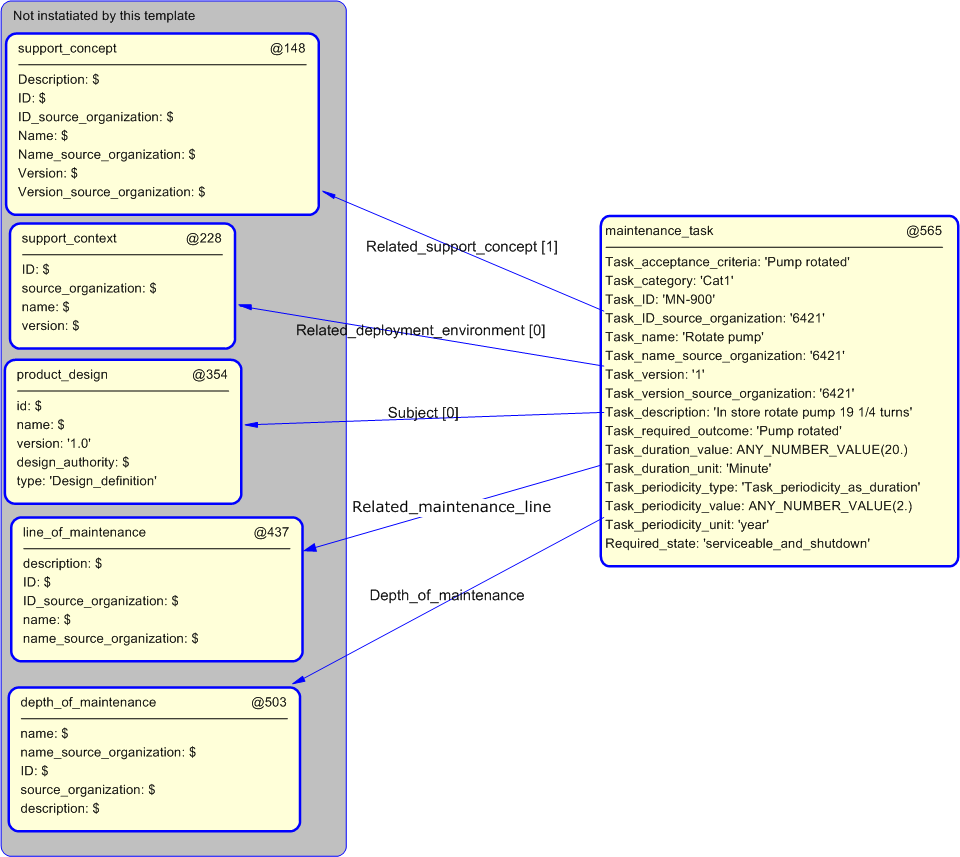Template:— maintenance_task (maint_task)
Context:— UK_Defence |
Date: 2009/10/02 12:37:34
Revision: 1.3
|
This section specifies the template maintenance_task.
NOTE
The template has been defined in the context of
UK_Defence.
Refer to the business context for details of related templates.
NOTE
An explanation of a template and the associated instantiation path is
provided in the
Template overview
section.
This template describes how to represent the UK_Defence concept of a maintenance task
in terms of PLCS model elements (templates, entities, and reference data)
This information object represents a task that is required to be performed on a subject that is a type of product.
This information object represents a task that is required to be performed on a subject that is a type of product.
Figure 1 — Graphical Representation for Business Object Maintenance Task
The attributes of the Maintenance Task object are tabled below. (note - this object inherits attributes from UK_Defence.task in addition to those shown below)
|
Attribute name
|
Attribute description
|
Attribute type
|
Optionality
|
| Depth of maintenance |
This is the depth of maintenance that the task is classified as. |
Relationship to Depth of maintenance |
Optional |
| Related deployment environment |
This is the reference to the deployment environment for which the task is defined. Currently, the mapping of this is an issue. |
Relationship to Support Context |
Mandatory |
| Related maintenance line |
This is the reference to the maintenance lines at which the task may be performed. |
Relationship to Line of Maintenance |
Optional |
| Related support concept |
This is the reference to the support concept for which the task is defined. Currently, the mapping of this is an issue. |
Relationship to Support Concept |
Mandatory |
| Required state |
This is the state in which an occurrence of the product design needs to be, for the task to be able to be performed. |
intrinsic |
Optional |
| Subject |
This is the reference to the product design for which the task is defined. |
Relationship to Product Design |
Mandatory |
Table 1 — Maintenance Task attribute details
The EXPRESS-G diagram in
Figure
2
shows the templates and EXPRESS entities that are required
to represent the template
"maintenance_task".
The text highlighted in blue shows the template parameters.
Figure 2 — An EXPRESS-G representation of the Information model for maintenance_task
The graphic for the template to be used in other EXPRESS-G diagrams
is shown in Figure
3
below.
Figure 3 — The graphical representation of the maintenance_task template
The following input parameters are defined for this template:
This is the acceptance criteria for the task
This is the category of the task.
The following classes and their sub-classes can be used:
classifications: [Task_category]![[warning:]](../../../../../../images/dex/warning.gif) Error RDL4: The URI urn:plcs:rdl:uk_defence is not listed in dexlib/data/refdata/rdl_index.xml
Error RDL4: The URI urn:plcs:rdl:uk_defence is not listed in dexlib/data/refdata/rdl_index.xml
The identifier of the organization responsible for the task identifier.
The identifier of the organization responsible for the task name.
The identifier of the organization responsible for the task version.
The description of the task.
This is the description of the required outcome of the task
The duration of the task expressed as a number of the time units represented in the parameter @Duration_unit.
The time units in which the duration is expressed.
The following classes and their sub-classes can be used:
The indication of whether periodicity is measured as number of times used or as a number of time units.
The following classes and their sub-classes can be used:
classifications: [Task_periodicity_as_usage]![[warning:]](../../../../../../images/dex/warning.gif) Error RDL4: The URI urn:plcs:rdl:uk_defence is not listed in dexlib/data/refdata/rdl_index.xml[Task_periodicity_as_duration]
Error RDL4: The URI urn:plcs:rdl:uk_defence is not listed in dexlib/data/refdata/rdl_index.xml[Task_periodicity_as_duration]![[warning:]](../../../../../../images/dex/warning.gif) Error RDL4: The URI urn:plcs:rdl:uk_defence is not listed in dexlib/data/refdata/rdl_index.xml
Error RDL4: The URI urn:plcs:rdl:uk_defence is not listed in dexlib/data/refdata/rdl_index.xml
The time or usage interval that determines when the Task should next be performed expressed as a number of the time
units represented in the parameter @Periodicity_unit
(if the @Periodicity_type parameter is set to
[Task_periodicity_as_duration]![[warning:]](../../../../../../images/dex/warning.gif) Error RDL4: The URI urn:plcs:rdl:uk_defence is not listed in dexlib/data/refdata/rdl_index.xml
Error RDL4: The URI urn:plcs:rdl:uk_defence is not listed in dexlib/data/refdata/rdl_index.xml);
or, as a number of usages
(if the @Periodicity_type parameter is set to
[Task_periodicity_as_usage]![[warning:]](../../../../../../images/dex/warning.gif) Error RDL4: The URI urn:plcs:rdl:uk_defence is not listed in dexlib/data/refdata/rdl_index.xml
Error RDL4: The URI urn:plcs:rdl:uk_defence is not listed in dexlib/data/refdata/rdl_index.xml).
The time or duration units in which the time interval that determines when the Task should next be performed is
expressed; or the class
[Count]![[warning:]](../../../../../../images/dex/warning.gif) Error RDL1: The class Count does not exist in RDL at URI urn:plcs:rdl:std. Check the dexlib/data/refdata/rdl_index.xml
Error RDL1: The class Count does not exist in RDL at URI urn:plcs:rdl:std. Check the dexlib/data/refdata/rdl_index.xml
when the periodicity is expressed as a number of usages.
The following classes and their sub-classes can be used:
The depth of maintenance to which the maintenance task is assigned.
The deployment environment to which the maintenance task is assigned.
The maintenance line to which the maintenance task is assigned.
The support concept to which the maintenance task is assigned.
The state of the product design for the task to be performed. The classes need to be agreed by the exchange partners.
These provided below are examples.
This is the reference to the product design for which the task is defined.
The following reference parameters are defined for this template:
Allow the
Task_method_version
entity instantiated in this path to be referenced when this template is used.
%^target = $maintenance_task.maint_task%
Allow the
Activity_property
entity instantiated in this path to be referenced when this template is used.
%^target = $maintenance_task.maint_task_duration%
The duration of the maintenance task.
Allow the
Activity_property
entity instantiated in this path to be referenced when this template is used.
%^target = $maintenance_task.maint_task_periodicity%
The periodicity of the maintenance task.
Allow the
Activity_property
entity instantiated in this path to be referenced when this template is used.
%^target = $maintenance_task.depth_of_maint%
The depth of maintenance of the task.
The following parameter combinations specify a uniqueness constraint:
Unique constraint: Unique maintenance task
The instantiation path shown below specifies the entities that are to be
instantiated by the template.
A description of templates and the syntax for the instantiation path is
provided in the
Templates Help/Information section.
-- Task /
task(
Acceptance_criteria=@Task_acceptance_criteria,
Category=@Task_category,
ID=@Task_ID,
ID_source_organization=@Task_ID_source_organization,
Version=@Task_version,
Version_source_organization=@Task_version_source_organization,
Name=@Task_name,
Name_source_organization=@Task_name_source_organization,
Description= @Task_description,
Required_outcome=@Task_required_outcome,
Duration_value=@Task_duration_value,
Duration_unit=@Task_duration_unit,
Periodicity_type=@Task_periodicity_type,
Periodicity_value=@Task_periodicity_value,
Periodicity_unit=@Task_periodicity_unit,
Subject=@Subject)/
-- Assign reference parameters %^maint_task = $task.task%
%^maint_task_duration = $task.duration%
%^maint_task_periodicity = $task.periodicity%
-- [ optional Depth_of_maintenance ] Classification_assignmentClassification_assignment.items ->
^maint_task
Classification_assignment.assigned_class ->
@Depth_of_maintenance-- Related_deployment_environment Task_method_assignmentTask_method_assignment.assigned_activity_method ->
^maint_task
Task_method_assignment.items ->
@Related_deployment_environment-- [ optional Related_maintenance_line] Classification_assignmentClassification_assignment.items ->
^maint_task
Classification_assignment.assigned_class ->
@Related_maintenance_lineTask_method_assignmentTask_method_assignment.assigned_activity_method ->
^maint_task
Task_method_assignment.items ->
@Related_support_concept-- [ optional Required_state ] /
assigning_reference_data(
class_name=@Required_state,
ecl_id='urn:plcs:rdl:uk_defence',
items=^maint_task)/
The instance diagram in Figure
4
shows an example of the EXPRESS entities and templates that are instantiated by the template:
/maintenance_task(Task_acceptance_criteria='Pump rotated', Task_category='Cat1', Task_ID='MN-900', Task_ID_source_organization='6421', Task_version='1', Task_version_source_organization='6421', Task_name='Rotate pump', Task_name_source_organization='6421', Task_description='In store rotate pump 19 1/4 turns', Task_required_outcome='Pump rotated', Task_duration_value='ANY NUMBER VALUE (20)', Task_duration_unit='Minute', Task_periodicity_type='Task_periodicity_as_duration', Task_periodicity_value='ANY NUMBER VALUE (2)', Task_periodicity_unit='year', Depth_of_maintenance='@503', Related_deployment_environment='@228', Related_maintenance_line='@437', Related_support_concept='@148', Required_state='serviceable_and_shutdown', Subject='@354')/
(an illustration of the consolidated maintenance_task template is shown in
Figure
5 below.)
Figure 4 — Entities instantiated by maintenance_task template
The instance diagram in
Figure
5
shows the graphic symbol for the template that is to be
used in other instance diagrams. The example template is:
/maintenance_task(Task_acceptance_criteria='Pump rotated', Task_category='Cat1', Task_ID='MN-900', Task_ID_source_organization='6421', Task_version='1', Task_version_source_organization='6421', Task_name='Rotate pump', Task_name_source_organization='6421', Task_description='In store rotate pump 19 1/4 turns', Task_required_outcome='Pump rotated', Task_duration_value='ANY NUMBER VALUE (20)', Task_duration_unit='Minute', Task_periodicity_type='Task_periodicity_as_duration', Task_periodicity_value='ANY NUMBER VALUE (2)', Task_periodicity_unit='year', Depth_of_maintenance='@503', Related_deployment_environment='@228', Related_maintenance_line='@437', Related_support_concept='@148', Required_state='serviceable_and_shutdown', Subject='@354')/
Figure 5 — Instantiation of maintenance_task template
Characterizations
No common characterizations of the template
maintenance_task
have been identified. However, the ISO 10303-239 EXPRESS model
may enable other assignments to the entities instantiated by the template.
